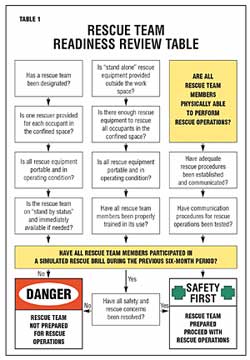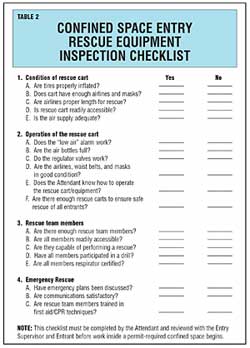Confined Space Entry, Part 5
All rescuers who enter the confined space must be trained and accounted for.
- By Stephen V. Magyar, Jr., MBA, CSP
- Jun 01, 2006
 CONFINED spaces can have many characteristics with numerous types of hazards. Escape from the roof of a burning building! Rescue from a swimming pool! Entrapment in a coal mine! Engulfment in an avalanche! Oxygen deficiency in a fuel tank! These are situations that are all too real to rescue personnel who conduct emergency rescue operations.
CONFINED spaces can have many characteristics with numerous types of hazards. Escape from the roof of a burning building! Rescue from a swimming pool! Entrapment in a coal mine! Engulfment in an avalanche! Oxygen deficiency in a fuel tank! These are situations that are all too real to rescue personnel who conduct emergency rescue operations.
Potential hazards must be clearly understood by all rescue personnel before attempting any rescue. The standard rule must be, "Understand before you leap, or you may be the next victim." Table No. 1 is a rescue team readiness review table.
There are two basic types of rescue: vertical and horizontal. Vertical rescues usually require a tripod and hoist system located directly above the confined space opening. The worker wears a harness with a life line attached when entering the space, and a ladder is used for immediate access. When an emergency develops, the hoisting system is used to remove the worker.
Horizontal rescues require the rescuer to enter the confined space and physically remove the worker. These rescues are difficult and require significant pre-planning and training. Physical stamina of the rescuers is a major consideration.
Horizontal rescues usually require one rescuer for each worker being rescued. A rescue can also involve a combination of horizontal and vertical removal techniques. In cases of engulfment or entrapment, other preliminary tasks (e.g., removal of debris, forced entry, etc.) may be required before the actual rescue can be attempted.
Team Members' Qualifications and Training
All rescuers who will be required to don rescue equipment must be clean shaven, certified, familiar with the hazards to be encountered inside the space, and physically able to make the rescue. Clean shaven usually means no facial hair (beards, mustaches, etc.). The certification process requires a respirator fit test, pulmonary function test, medical examination and evaluation, and periodic training in the use of emergency rescue equipment.
Hazard communication or similar training designed to ensure that rescuers understand potential hazards inside the work space and their effects on the human body also must be provided. Finally, all rescue team members must be physically able to conduct the immediate rescue. Tall rescuers will not function well in limited-clearance work spaces. Large rescuers will not fit into work spaces with small access openings. These additional restrictions must be considered when selecting and training rescue team members.
Rescue teams generally include a team leader who is trained in CPR techniques. Standard American Red Cross or American Heart Association certification programs are sufficient.
All rescue equipment must be sufficient to ensure a complete rescue and must be readily available and in operating condition. Portable carts must have inflated tires. Air lines and masks must be available. There must be a sufficient supply of breathable air that is monitored for particulate, condensate, and carbon monoxide. Low air supply alarms must be operable, and a cascade air supply system should be provided. Table No. 2 provides an equipment readiness checklist.
When work permits are completed and posted, all rescue team members must be placed on "stand-by status" while work is being performed inside the confined space. Any change must be reported to, and approved by, the Attendant before the change is completed. There can be no exception to this requirement.
"Out to lunch," "On vacation," or "Temporarily assigned elsewhere" is a poor excuse when an emergency rescue is necessary. Depending on outside agencies to make emergency rescues from Immediately Dangerous to Life and Health (IDLH) work environments does not provide the Entrant with a "comfortable feeling" should an emergency develop. Emergency help must be immediately available.
Rescue Drills
An emergency plan must be established, and communication equipment must be operable, with procedures clearly understood, before any rescue is attempted. All rescuers who enter the confined space must be trained and accounted for.
Rescue drills conducted at six-month intervals, with performance reviews and critique sessions following each drill, will hone rescue skills and ensure safe rescues. These drills should require the use of all required rescue equipment in simulated rescue conditions. All safety issues and concerns must be discussed. Procedural and/or equipment changes that will ensure optimal performance during rescue operations must be made.
Air Monitoring
The environment in which the rescue will be attempted must be considered. Adequate safety equipment is available for safe entry into oxygen deficient or chemically contaminated environments. When an explosive hazard is suspected, preliminary monitoring is needed before entry. Oxygen levels above 26.5 percent are explosive and must be purged or diluted with fresh air to reduce the hazard before attempting a rescue. Failure to reduce the oxygen level places the rescuer at extreme risk for which there is no adequate protection.
Rescue Equipment Maintenance
All rescue team members must remain current with their training and certifications. This should include semi-annual practice drills, annual physical examinations and respirator training, and periodic meetings to discuss safety issues and concerns. Rescuers who have grown beards, developed physical limitations, or requested removal from rescue operations should be removed from the list of rescuers.
Adequate programs to ensure effective maintenance of rescue equipment also must be established. Routine preventative maintenance and/or follow-up maintenance after each use usually will provide required results. Missing or defective rescue equipment must be replaced before confined space work resumes.
The Entrant must review the readiness table before entry into any confined work space and must be given the opportunity to challenge any of the required readiness elements. All safety concerns the Entrant may express must be addressed and resolved before entry into the work space. The Entrant is the one team member who is "most at risk" and, accordingly, must have the right to approve all rescue operations.
Review: Team Members' Roles
Work inside confined spaces can be safely accomplished when all members of the work team understand their roles in completing the task safely.
1. The Entry Supervisor establishes the rules.
2. The Attendant enforces the rules.
3. The Entrant performs the work.
4. The Atmosphere Evaluator monitors hazards.
5. The Rescue Team responds in an emergency.
Cooperation among all team members is the key to safe and successful confined space entry work.
This article appears in the June 2006 issue of Occupational Health & Safety.
References
1. American National Standards Institute, Safety Requirements For Working In Tanks and Other Confined Spaces, Z117.1.
2. Bender, Thomas R., et al., Worker Deaths in Confined Spaces: A Summary of Surveillance Findings and Investigative Case Reports, U.S. Department of Health and Human Services, Publication No. 94-103.
3. National Institute for Occupational Safety and Health, Criteria for a Recommended Standard: Working in Confined Spaces (Publication No. 80-106).
4. National Institute for Occupational Safety and Health, A Guide to Safety in Confined Spaces (Publication No. 87-113).
5. National Safety Council, Confined Space Entry Control System for R&D Operations, Data Sheet No. 704.
6. U.S. Department of Labor, Code of Federal Regulations, Part 1910.146, Permit Required Confined Spaces.
Series at a Glance
This article concludes author Stephen V. Magyar Jr.'s five-part series on confined space entry. The first installment in the series appeared in the February 2006 issue of OH&S, with a subsequent article appearing each month. All are available at www.ohsonline.com; just search for "Magyar" after clicking on the Article Search link.
Confined Space Entry, Part 1 outlines elements of a confined space work program, offering sample permits and discussing requirements for all members of an entry team.
Confined Space Entry, Part 2 enumerates the multiple responsibilities of attendants, the "guardian angels" of the confined space entry team.
Confined Space Entry, Part 3 explores the extreme risks of confined space work and declares a "Bill of Rights" for workers who make entries.
Confined Space Entry, Part 4 directs attention to the team member who provides the early warning signs of danger, the atmosphere evaluator.
This article originally appeared in the June 2006 issue of Occupational Health & Safety.